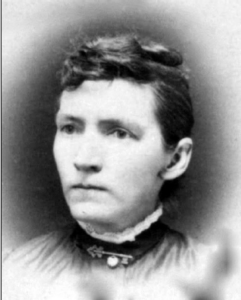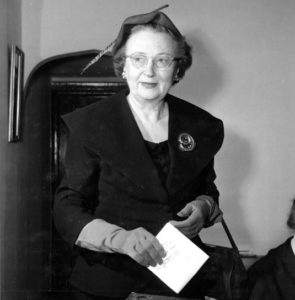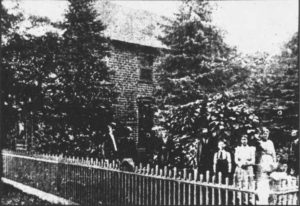UTAH WOMEN’S HISTORY / Explore the History / Utah Counties / Utah

Utah County
A large suffrage rally in American Fork, Utah on July 29, 1892 featured yellow as the color of suffrage: “Ladies wore the yellow ribbon and many gentlemen the sunflower…and the entire day was a grand feast of suffrage sentiment.” Local suffrage associations often held social events to raise money and awareness for the cause.

Utah County suffragists Electa Bullock, Sarah A. Boyer, and Hannah S. Lapish signed this petition for equal suffrage to the constitutional convention. More suffragists signed petitions for suffrage over the next month.

Ellen Jakeman became the first elected female county official from Utah county in 1896 when she won the position of county treasurer. The all-male county commissioner board wrote of her ability to give “a piece of her mind” to whomever she seemed fit, and she was a fearless speaker who never backed down from a political fight.

The women of the Utah county Democratic club urged the county council to reconsider its plan to nominate only men for county offices in 1900. The women demanded “visible recognition” of the joint responsibility of male and female voters, and protested the unequal pay of male and female county clerks.
Key Players
Utah County Woman Suffrage Association

“The Suffragists,” Provo Daily Enquirer, December 17, 1894.
The Utah County Woman Suffrage Association was organized as a branch of the Utah Woman Suffrage Association, established in 1889 to regain suffrage for Utah women. The Utah county chapter was especially active, with well-attended grassroots branches in Provo, American Fork, Springville, Pleasant Grove, and elsewhere. These chapters held meetings where women and men gathered monthly to sing, pray, and give speeches and lessons on women’s suffrage, civics, and other issues of the day. Suffragists in Utah county sent delegates to national suffrage conventions and they contributed hundreds of signatures to petitions in favor of equal suffrage that were sent to the Utah constitutional convention in 1895. Electa Bullock served as President of the Utah County association for most of the 6 years of its operation, with many other women serving as vice presidents and members of the executive committee, including Mary John, Marilla Daniels, Ellen Jakeman, Mrs. McBride, Malena Wilkins, Caroline Pratt, and Johanna Patten. Women from American Fork (Hannah Lapish), Pleasant Grove (Fannie Stewart), Lehi (Mrs. Gaddy), Springville (Sarah A. Boyer), and Spanish Fork (Mrs. Lewis) served on the board.
Electa Wood Bullock

Electa Wood Bullock. Photograph courtesy of Dorothy Bullock Lynn.
“We affirm that with woman’s influence withdrawn from governmental affairs, anarchy would prevail; withdraw her labor from the manufacturing establishments of the land and its wheels would become stilled; dispense with her in our schools and the grand educational systems of today would degenerate to the darkness of the long past; banish her from the arts and they would lose their very divinity; take her from the industrial walks and avocations of life and confine her exclusively to the narrow sphere of house-wife and maid-servant, and the wheels of progress would turn backward and the retrogression of society would be the inevitable result. On the contrary, support her in her proud position of wife and mother, sustain her in every advance movement, and the women of America will lead society onward and upward, from civilization to civilization, through endless stages of progress.”
When Electa Wood Bullock penned these words as part of her “Industrial Women” speech for the 1893 Chicago World’s Fair, most everyone in Utah county was already familiar with her name. She had lived in Springville and then Provo for more than 30 years making a name for herself as an actress, hotel proprietor, wife, mother, grandmother, and ardent suffragist. As her name suggests, Electa spent much of her later years actively involved in politics at the local, state, and national levels. In 1891, she was elected president of the Woman Suffrage Association of Utah County, a position she maintained for nearly 2 decades. She was also elected as a delegate to the 1891 National Women’s Suffrage Convention held in Washington DC. In 1893, she was selected as a manager for the Utah exhibit of the Chicago World’s Fair, and in 1895, she was an appointed delegate to the Cotton States Exposition in Atlanta, GA.
Ellen C. Jakeman

Ellen Jakeman in the Deseret Evening News, April 7, 1900.
After working for years in the San Pete and Utah County Suffrage Associations, Ellen Jakeman became the first elected female county official from Utah county in 1896 when she won the position of county treasurer. The all-male county commissioner board wrote of her ability to give “a piece of her mind” to whomever she seemed fit, and she was a fearless speaker who never backed down from a political fight. The Deseret Evening News claimed that she “seems to have been born a disciple of the doctrine of Woman’s Rights. She has always been outspoken for her political principles and has never been afraid to stand alone, nor to be unpopular.” Ellen was an acclaimed writer, working for several Utah papers, and also the Young Woman’s Journal. She also served as president of the first San Pete County Woman Suffrage Association, and later as secretary of the Utah County Woman Suffrage Association.
Fannie Eliza Hunt Stewart

Courtesy of Laurel Cunningham.
Fannie Eliza Hunt Stewart was the first Utah County woman to run for state office. Fannie was a schoolteacher in Pleasant Grove and supported herself and her children after her husband died when she was 30. When suffrage associations organized throughout Utah to regain women’s right to vote, Fannie became the vice president of the Utah County Woman Suffrage Association representing Pleasant Grove. When Pleasant Grove organized its own WSA, Fannie was elected president. In 1896, the first year Utah women could run for public office, Fannie ran for the state house of representatives on Utah County’s Republican ticket, but she and the other Republicans were defeated in a Democratic landslide. In 1901, Fannie moved to Provo and began working as a nurse and schoolteacher at the State Mental Hospital. She remained active in politics as a member of the Ladies Republican Club and assistant secretary of the Republican Party committee in Utah County. Fannie spent the last years of her life in Naples, Uintah County, near her married daughter, where she continued her involvement in county politics.
Amy Brown Lyman

Photograph courtesy of the Utah State Historical Society.
Amy Brown Lyman graduated from BYU in 1890, beginning a long career of community service, social work, and advocacy for women. She was involved in Settlement House programs run by Jane Addams and was elected as delegate to National Conference of Social Work in 1917. She was prominent in the LDS church’s Relief Society and headed the Relief Society Social Services for 16 years, including 13 years as General Secretary of the Relief Society. In this capacity, she spearheaded 126 welfare institutes that trained over 4,000 volunteers in family welfare work across the western United States. She was also a leader in the Utah Red Cross.
Lyman served as a Utah state representative from 1923-1924 representing Pleasant Grove. She pushed for statewide support of the Sheppard-Towner Act during her time in the state House, which provided federal funding for mothers and children and improved medical care. She was a delegate to the International Peace Meeting of Women in 1925, and was named Recording Secretary of the National Council of Women later that year. In 1927, she was nominated as an American delegate to the International Council of Women conference in Geneva, Switzerland, where she not only represented Utah women, but women across the nation.
Reva Beck Bosone

Reva Reck Bosone, 1954. Photograph courtesy of the Utah State Historical Society.
“Our Road is Onward” was the motto for the American Fork district of Utah County schools when Reva Beck Bosone graduated high school in 1910. Her road most certainly continued onward, as she holds the honor of being the first female Congresswoman from Utah and also the first female elected judge in the state. After finishing school in American Fork, she continued her education at Westminster College, UC Berkeley, and ultimately the University of Utah Law School. Bosone and her husband practiced law in Helper, Utah for several years before relocating to Salt Lake. Prior to her election to the US House of Representatives in 1948 and 1950, she was elected as a state congresswoman in 1932 and 1934. During her tenure as state delegate, she sponsored bills advocating for minimum wage for women and children. In 1936, she was elected and served 3 terms as a Salt Lake City judge. Once elected to the US Congress, Reva paid particular attention to reclamation projects and American Indian policy.
Key Events
American Fork Suffrage Rally - July 29, 1892
A large suffrage rally in American Fork, Utah on July 29, 1892 featured yellow as the color of suffrage: “Ladies wore the yellow ribbon and many gentlemen the sunflower…and the entire day was a grand feast of suffrage sentiment.” Local suffrage associations often held social events to raise money and awareness for the cause.
Utah County petitions for equal suffrage - March and April 1895
 During Utah’s constitutional convention in 1895, women’s suffrage was a hotly-debated topic. Although a majority of Utahns supported women’s right to vote and both political parties pledged to support restoring women’s suffrage, some delegates to the convention argued that the issue should be postponed until after statehood. Utah county suffragists were among those who petitioned the convention to remember their promises.
During Utah’s constitutional convention in 1895, women’s suffrage was a hotly-debated topic. Although a majority of Utahns supported women’s right to vote and both political parties pledged to support restoring women’s suffrage, some delegates to the convention argued that the issue should be postponed until after statehood. Utah county suffragists were among those who petitioned the convention to remember their promises.
On March 15, 1895, three Utah County suffrage leaders sent a petition to the convention asking for equal suffrage. Electa Bullock, Sarah A. Boyer, and Hannah S. Lapish reminded delegates that women had been “deprived of the privileges of American citizenship… taxed and are amenable to the laws equal with men … [and have] no voice or vote.”
On April 11, 1895, a petition containing 1,110 names from Utah County was presented in favor of including an equal suffrage clause in the state constitution. The next day, several petitions were introduced both for and against the inclusion of suffrage from Utah County residents. Utah County supported the cause of suffrage until it was safely included in Utah’s proposed constitution.
Provo Women Speak Out - August 24, 1900

Salt Lake Tribune, August 25, 1900.
“We resent the intimation that in spite of equal suffrage the women of Utah remain nonentities.” In 1900, the women of the Utah county Democratic club publicly urged their county council to reconsider its plan to nominate only men for county offices at the turn of the 20th century. The expectation was clear–Amanda Knight, Alice Thurman, Belle Nelson, Electa Bullock, and Rose Young, the officers of the club, demanded “visible recognition” of the joint responsibility that both male and female voters share. They also made special protest “against discrimination in salary on account of sex.” While working as first-deputy county recorder from 1898-1899, Rose Young had a fixed salary $10 less per month than her male second-deputy counterpart. These women had first hand experience enough to claim, “where labor and responsibility are equal we contend for equal compensation.”
Key Sites
Boyer Hotel - Springville WSA

Boyer Hotel. The Daily Herald, Apr. 2, 2006.
The Springville Woman Suffrage Association, formed in September 1892, frequently met in the Old Meeting House in Springville or at the residence of President Sarah Ann Boyer, which was also the Boyer Hotel. Over 100 members of the Springville WSA would meet at these locations for speeches, songs, dinners, etc. The Boyer Hotel was located on 100 South 300 West.
Share Your History
We would love to hear from you about the women’s advocates in your family or community. Send us an email at stories@betterdays2020.org.

